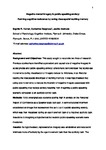Negative mental imagery in public speaking anxiety: Forming cognitive resistance by taxing visuospatial working memory
| dc.contributor.author | Homer, Sophie | |
| dc.contributor.author | Deeprose, Catherine | |
| dc.contributor.author | Andrade, Jackie | |
| dc.date.accessioned | 2017-02-01T09:30:46Z | |
| dc.date.available | 2017-02-01T09:30:46Z | |
| dc.date.issued | 2016-03 | |
| dc.identifier.issn | 0005-7916 | |
| dc.identifier.issn | 1873-7943 | |
| dc.identifier.uri | http://hdl.handle.net/10026.1/8340 | |
| dc.description | publisher: Elsevier articletitle: Negative mental imagery in public speaking anxiety: Forming cognitive resistance by taxing visuospatial working memory journaltitle: Journal of Behavior Therapy and Experimental Psychiatry articlelink: http://dx.doi.org/10.1016/j.jbtep.2015.05.004 content_type: article copyright: Copyright 2015 Elsevier Ltd. All rights reserved. | |
| dc.description.abstract |
BACKGROUND AND OBJECTIVES: This study sought to reconcile two lines of research. Previous studies have identified a prevalent and causal role of negative imagery in social phobia and public speaking anxiety; others have demonstrated that lateral eye movements during visualisation of imagery reduce its vividness, most likely by loading the visuospatial sketchpad of working memory. It was hypothesised that using eye movements to reduce the intensity of negative imagery associated with public speaking may reduce anxiety resulting from imagining a public speaking scenario compared to an auditory control task. METHODS: Forty undergraduate students scoring high in anxiety on the Personal Report of Confidence as a Speaker scale took part. A semi-structured interview established an image that represented the participant's public speaking anxiety, which was then visualised during an eye movement task or a matched auditory task. Reactions to imagining a hypothetical but realistic public speaking scenario were measured. RESULTS: As hypothesised, representative imagery was established and reduced in vividness more effectively by the eye movement task than the auditory task. The public speaking scenario was then visualised less vividly and generated less anxiety when imagined after performing the eye movement task than after the auditory task. LIMITATIONS: Self-report measures and a hypothetical scenario rather than actual public speaking were used. Replication is required in larger as well as clinical samples. CONCLUSIONS: Visuospatial working memory tasks may preferentially reduce anxiety associated with personal images of feared events, and thus provide cognitive resistance which reduces emotional reactions to imagined, and potentially real-life future stressful experiences. | |
| dc.format.extent | 77-82 | |
| dc.format.medium | Print-Electronic | |
| dc.language | en | |
| dc.language.iso | en | |
| dc.publisher | Elsevier BV | |
| dc.subject | EMDR | |
| dc.subject | Imagery | |
| dc.subject | Public speaking | |
| dc.subject | Social anxiety | |
| dc.subject | Eye movements | |
| dc.subject | Working memory | |
| dc.title | Negative mental imagery in public speaking anxiety: Forming cognitive resistance by taxing visuospatial working memory | |
| dc.type | journal-article | |
| dc.type | Journal Article | |
| plymouth.author-url | https://www.webofscience.com/api/gateway?GWVersion=2&SrcApp=PARTNER_APP&SrcAuth=LinksAMR&KeyUT=WOS:000367213200010&DestLinkType=FullRecord&DestApp=ALL_WOS&UsrCustomerID=11bb513d99f797142bcfeffcc58ea008 | |
| plymouth.volume | 50 | |
| plymouth.publication-status | Published | |
| plymouth.journal | Journal of Behavior Therapy and Experimental Psychiatry | |
| dc.identifier.doi | 10.1016/j.jbtep.2015.05.004 | |
| plymouth.organisational-group | /Plymouth | |
| plymouth.organisational-group | /Plymouth/Admin Group - REF | |
| plymouth.organisational-group | /Plymouth/Admin Group - REF/REF Admin Group - FoH | |
| plymouth.organisational-group | /Plymouth/Faculty of Health | |
| plymouth.organisational-group | /Plymouth/Faculty of Health/School of Psychology | |
| plymouth.organisational-group | /Plymouth/REF 2021 Researchers by UoA | |
| plymouth.organisational-group | /Plymouth/REF 2021 Researchers by UoA/UoA04 Psychology, Psychiatry and Neuroscience | |
| plymouth.organisational-group | /Plymouth/REF 2021 Researchers by UoA/UoA04 Psychology, Psychiatry and Neuroscience/UoA04 Psychology, Psychiatry and Neuroscience MANUAL | |
| plymouth.organisational-group | /Plymouth/REF 2021 Researchers by UoA/UoA04 Psychology, Psychiatry and Neuroscience/UoA04 REF peer reviewers | |
| plymouth.organisational-group | /Plymouth/Research Groups | |
| plymouth.organisational-group | /Plymouth/Research Groups/Centre for Brain, Cognition and Behaviour (CBCB) | |
| plymouth.organisational-group | /Plymouth/Research Groups/Centre for Brain, Cognition and Behaviour (CBCB)/Cognition | |
| plymouth.organisational-group | /Plymouth/Research Groups/Institute of Health and Community | |
| plymouth.organisational-group | /Plymouth/Research Groups/Plymouth Institute of Health and Care Research (PIHR) | |
| plymouth.organisational-group | /Plymouth/Users by role | |
| plymouth.organisational-group | /Plymouth/Users by role/Academics | |
| dc.publisher.place | Netherlands | |
| dcterms.dateAccepted | 2015-05-14 | |
| dc.rights.embargodate | 2016-11-21 | |
| dc.identifier.eissn | 1873-7943 | |
| dc.rights.embargoperiod | No embargo | |
| rioxxterms.versionofrecord | 10.1016/j.jbtep.2015.05.004 | |
| rioxxterms.licenseref.uri | http://www.rioxx.net/licenses/all-rights-reserved | |
| rioxxterms.licenseref.startdate | 2016-03 | |
| rioxxterms.type | Journal Article/Review |


